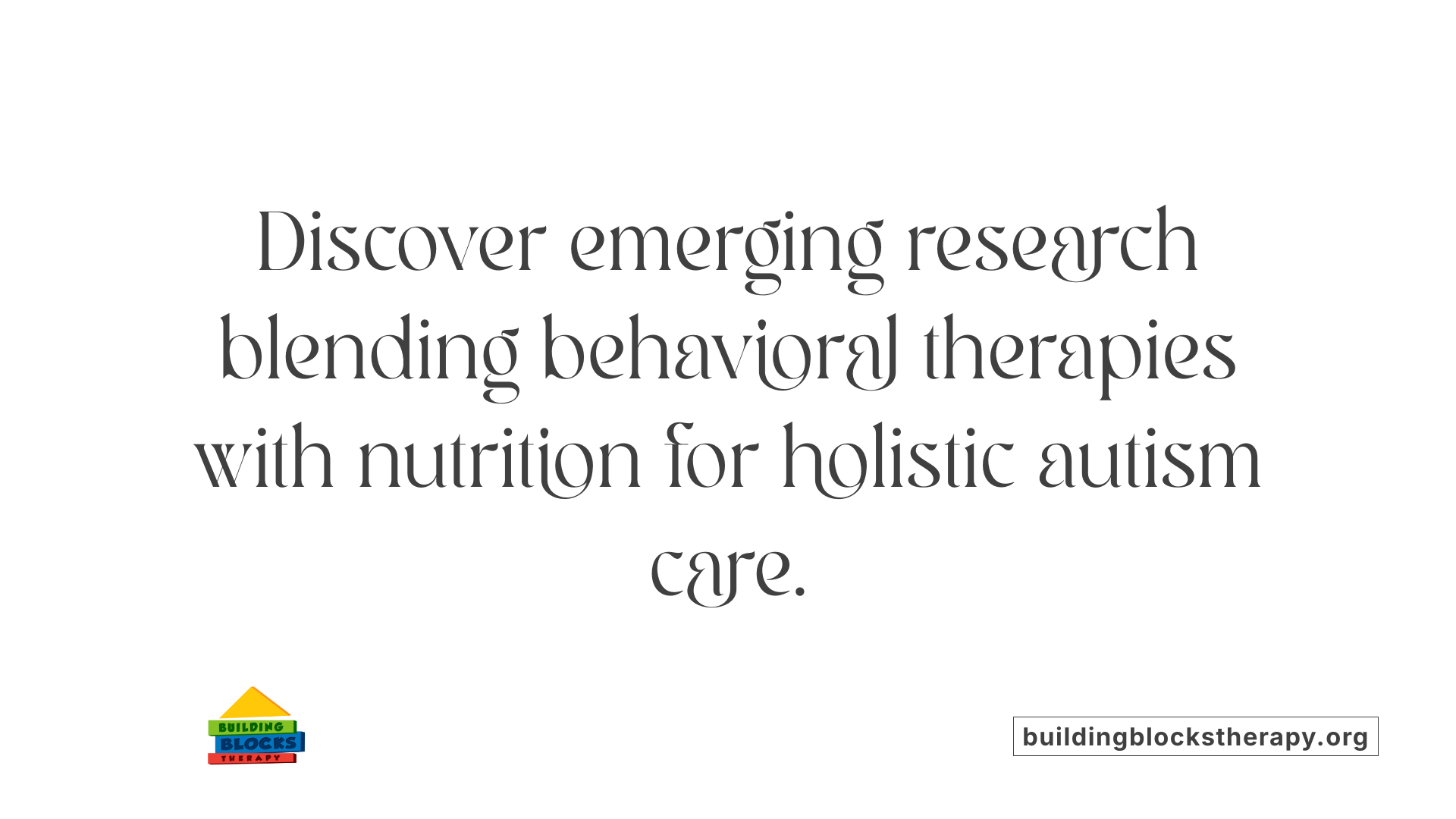Dairy And Autism
Understanding Autism: Behavioral Approaches and Nutritional Considerations

Exploring the Complexities of Autism and Therapy Options
Autism spectrum disorder (ASD) encompasses a variety of developmental challenges that impact communication, behavior, and social interaction. Alongside therapeutic interventions like Applied Behavior Analysis (ABA), understanding how lifestyle and dietary factors such as dairy consumption affect individuals with autism has become an area of interest for families and professionals alike. This article delves into the fundamentals of ABA therapy, its benefits, providers, and techniques, while also considering the role nutrition, specifically dairy, may play in autism spectrum conditions.
What is Applied Behavior Analysis (ABA) Therapy?
Definition and Purpose of ABA Therapy
Applied Behavior Analysis (ABA) therapy is a science-based approach designed to improve behaviors in individuals, primarily those with autism spectrum disorder. Its main goal is to encourage positive skills such as communication and social interaction while decreasing challenging or harmful behaviors.
Use of Reinforcement and the A-B-C Model
ABA therapy relies heavily on reinforcement strategies and uses the A-B-C model—antecedent, behavior, and consequence—to understand and modify behavior effectively. By analyzing what happens before and after a behavior, therapists can identify triggers and reinforce desirable responses.
Individualized Program Design
Programs in ABA therapy are tailored specifically to each individual's strengths and needs. Board Certified Behavior Analysts (BCBAs) create and supervise these customized plans to ensure the best possible outcomes for the person receiving therapy.
Settings Where ABA is Delivered
ABA therapy can be provided in a variety of settings, including the client's home, school, or community environments. This flexibility helps apply learned skills across multiple real-life situations, promoting generalization.
Evidence Base and Outcomes
ABA therapy is an evidence-based practice supported by decades of research. Early and consistent treatment often results in significant improvements in communication, social skills, and daily living abilities, contributing to better overall development.
How ABA Therapy Benefits Individuals with Autism
What skills are taught by ABA therapy?
ABA therapy targets essential skills that support daily living and independence. These include communication techniques such as requesting and expressing feelings, social interaction skills like turn-taking and eye contact, self-care routines including dressing and grooming, and academic abilities tailored to each individual’s learning goals.
How does positive behavior reinforcement work in ABA?
Positive behavior reinforcement is a central strategy in ABA. It involves rewarding desired behaviors to increase their occurrence. For example, a child who uses words instead of gestures to ask for an item might receive praise or a favorite activity as a reward, encouraging continued use of verbal communication.
How does ABA reduce challenging behaviors?
By carefully analyzing what happens before and after a challenging behavior (antecedents and consequences), ABA practitioners identify triggers and motivations. They then develop customized interventions to replace undesirable behaviors with more appropriate alternatives, reducing occurrences of behaviors such as aggression or self-injury.
Why is early and intensive intervention important?
Starting ABA therapy early maximizes developmental gains as the brain is highly adaptable during early childhood. Intensive programs, often involving multiple hours per week, provide consistent practice and reinforcement. This approach has been linked to significant improvements in social skills, communication, and cognitive functioning.
What overall developmental improvements are seen with ABA?
Individuals receiving ABA therapy often show enhanced independence, better communication abilities, and improved social participation. These progressions contribute to higher quality of life and increased opportunities to engage meaningfully with family, school, and the community.
Providers of ABA Therapy Services
Who provides ABA therapy services?
ABA therapy services are usually delivered by specialized professionals trained in behavior analysis. The primary providers include Board Certified Behavior Analysts (BCBAs) who design and oversee therapy programs, and registered behavior technicians (RBTs) who carry out day-to-day therapy sessions under BCBA supervision.
Types of professionals involved
- BCBAs: Responsible for conducting initial evaluations, developing individualized treatment plans, and adjusting interventions based on progress.
- RBTs: Implement therapy strategies directly with the child, collecting data and providing consistent instruction.
Initial evaluations and treatment planning
Before treatment begins, BCBAs perform comprehensive assessments to identify the child's specific needs and skills. This evaluation guides the creation of a tailored intervention plan aimed at teaching communication, social, and behavioral abilities.
Importance of caregiver involvement and training
Caregivers play a crucial role by learning techniques used during therapy to support skill development at home. This consistent reinforcement helps solidify progress and generalize skills across all environments.
Settings where ABA is implemented
ABA therapy is versatile and can be provided in various settings, including clinics, schools, homes, and community environments. This flexibility allows therapy to be integrated into everyday contexts for greater impact.
Common Techniques Utilized in ABA Therapy
What techniques are commonly used in ABA therapy?
Applied Behavior Analysis (ABA) therapy uses several effective approaches to promote behavior change and skill development. One primary method is positive reinforcement, where desirable behaviors are encouraged through rewards to increase their frequency.
Prompting and fading are also essential techniques. Prompting involves offering cues or assistance to initiate a behavior, which is gradually reduced (fading) to foster independence. Behavior chaining breaks down complex tasks into smaller, manageable steps taught sequentially, enhancing learning.
Modeling involves demonstrating desired behaviors for imitation, while visual modeling and script fading are used to improve communication and social skills, especially in children with autism. Script fading gradually removes prompts from practiced dialogues to achieve spontaneous use.
Behavior contracts set clear expectations and consequences, motivating individuals to meet behavioral goals. Redirection helps manage challenging behaviors by shifting attention toward appropriate actions.
Crucially, these methods are tailored to each individual's needs to maximize their effectiveness. ABA therapy’s diverse and evidence-based strategies work together to support meaningful and lasting behavior improvements.
Is ABA Therapy Suitable for All Individuals with Autism?
How Does Individual Variability Affect ABA Therapy Outcomes?
ABA therapy is widely recognized for its effectiveness in supporting individuals with autism, especially in enhancing communication and social skills while reducing challenging behaviors. However, not every individual responds to ABA therapy in the same way. Variations in cognitive abilities, communication levels, and personal preferences mean that what works well for one person may be less effective for another.
Why Is Personalized Assessment Important?
A personalized assessment is crucial to designing an ABA program that addresses the unique strengths and needs of each individual. Therapists evaluate developmental profiles and behavioral challenges to tailor interventions that are meaningful and achievable. This customization helps maximize therapy benefits and fosters greater engagement.
Can ABA Therapy Be Used Beyond Autism?
Although ABA originated as a treatment for autism, its principles are adaptable to other conditions. It has been successfully applied in managing behavioral issues in disorders such as ADHD, obsessive-compulsive disorder (OCD), and even after traumatic brain injury. This versatility underscores the therapy's broad utility beyond the autism spectrum.
Is Professional Consultation Necessary?
Determining if ABA therapy is appropriate requires consultation with qualified professionals. Caregivers and therapists collaborate to assess the individual's needs, preferences, and goals. This team approach ensures that decisions about starting or modifying ABA interventions are informed and considerate of the person’s well-being.
What Are the Limitations and How Can ABA Be Adapted?
No single therapy fits all, and ABA is no exception. Some individuals may find the intensity or structure of ABA challenging or may not respond as expected. Fortunately, ABA programs can be adapted—adjusting intensity, techniques, and goals—to better align with an individual's comfort and progress.
Choosing the Right ABA Therapy Provider: What Families Should Know

What should families consider when choosing an ABA therapy provider?
Families seeking ABA therapy should start by verifying that therapists hold certifications from reputable organizations like the Behavior Analyst Certification Board (BACB). This ensures therapists have the necessary training, supervision, and experience to provide effective treatment.
Equally important is understanding the provider’s approach. Look for individualized, evidence-based treatment plans tailored to your child's unique needs. These plans should rely on data-driven methods and actively include family input to promote meaningful progress.
Consider the therapy setting and structure. Effective ABA programs offer sessions in environments where skills can generalize to everyday life, using positive and respectful techniques that engage the child rather than relying on aversive methods.
Transparency about costs, billing, and session scheduling is vital. Providers who communicate openly and coordinate well with other professionals involved in your child's care help ensure a smooth therapy experience.
Families should also watch for red flags such as lack of supervision, minimal progress updates, or use of punitive strategies. Awareness of these issues helps families choose providers who follow ethical practices and prioritize the child’s well-being.
The Potential Influence of Dairy on Autism
Current research on dairy and autism
Recent studies have explored how dairy consumption might affect behaviors associated with autism spectrum disorder (ASD). While research remains inconclusive, some findings suggest that certain children with autism may exhibit heightened sensitivities to dairy products, potentially impacting gastrointestinal health and behavioral symptoms.
Reported dietary sensitivities and behaviors
Parents and caregivers frequently report that some children with ASD display adverse reactions to dairy, such as increased irritability, gastrointestinal discomfort, or changes in attention and mood. These observations have led to increased interest in dietary adjustments aimed at improving quality of life.
Overview of dietary interventions including dairy-free approaches
Dairy-free diets are one of several dietary interventions explored as a means to alleviate ASD symptoms. Some families adopt gluten-free, casein-free regimens, hypothesizing that removing dairy proteins like casein may reduce symptoms. Although anecdotal reports exist, scientific consensus is still in development.
Considerations for individualized nutrition plans
Because of the variability in responses to dairy among individuals with autism, personalized nutrition is critical. Health care providers often recommend monitoring symptoms carefully when making dietary changes and ensuring balanced nutrition when excluding any food group.
Role of healthcare professionals in dietary guidance
Healthcare professionals play an essential role by providing evidence-based advice, helping families navigate dietary options, and supporting nutritional adequacy through tailored plans. Collaboration between caregivers, dietitians, and clinicians ensures that dietary interventions are safe and effective.
Integrating Nutritional Strategies with ABA Therapy

Combining dietary changes with behavioral therapy
Integrating nutritional strategies with Applied Behavior Analysis (ABA) therapy involves aligning dietary modifications with behavioral goals. Adjusting a child's diet to include balanced nutrients can support ABA's efforts by potentially improving attention, reducing irritability, and enhancing overall well-being.
Ensuring comprehensive care through multidisciplinary teams
Successful integration often requires collaboration among behavior analysts, nutritionists, and medical professionals. This team approach ensures that nutritional interventions complement behavioral strategies, creating a more effective, personalized care plan for the individual.
Importance of monitoring changes in behavior related to diet
Careful observation and documentation of behavioral changes following dietary adjustments are crucial. This allows therapists and caregivers to determine which nutritional changes positively impact behavior and to modify interventions accordingly.
Guidance for caregivers on holistic approaches
Caregivers play a vital role in managing both dietary and therapeutic routines. Providing them with education on nutrition’s role in behavior and strategies for consistent implementation fosters a supportive environment that aligns with ABA goals.
Potential benefits and limitations of nutrition adjustments
While nutritional changes may offer benefits such as improved focus and decreased behavioral challenges, it is important to recognize that diet alone is not a standalone treatment. Integrating nutrition with ABA therapy provides a holistic approach but should be balanced with realistic expectations and professional oversight.
Family and Caregiver Roles in Supporting Therapeutic and Dietary Interventions

Training Caregivers in ABA Techniques
Families and caregivers play a crucial role in applying Applied Behavior Analysis (ABA) techniques consistently. Proper training helps them understand behavioral cues and reinforces desired behaviors effectively, ensuring therapeutic benefits extend beyond clinical settings.
Supporting Consistent Therapy Application at Home
Consistency is vital for the success of interventions. Caregivers are encouraged to integrate therapy routines into daily activities, creating a structured environment that fosters skill development and behavioral improvements.
Monitoring Dietary Impacts and Symptoms
Dietary factors can influence behavior and overall health. Caregivers should carefully observe any changes in symptoms related to dietary interventions, maintaining detailed records to inform healthcare providers and nutritionists.
Collaborative Approaches with Therapists and Nutritionists
Open communication between families, therapists, and nutritionists ensures a holistic approach. Regular meetings allow for adjustments in therapeutic strategies and dietary plans tailored to the individual's evolving needs.
Empowering Families Through Education and Support
Providing educational resources and support groups empowers families to advocate effectively. Access to knowledge fosters confidence and resilience, equipping caregivers to navigate challenges and celebrate progress with their loved ones.
Future Perspectives on Autism Treatment: Behavioral and Nutritional Synergies

What are the Emerging Research Trends in Autism Treatment?
Recent studies emphasize integrating behavioral therapies with nutritional strategies to enhance overall outcomes for individuals with autism. Advances in understanding gut-brain interactions and the microbiome's role suggest nutrition could influence behavioral symptoms, encouraging a more holistic treatment approach.
How Might Personalized Medicine Shape Autism Care?
Personalized medicine is gaining traction by tailoring interventions based on genetic, metabolic, and environmental factors unique to each individual. This approach aims to optimize therapy effectiveness by combining specific behavioral methods with targeted nutritional plans.
How Can Therapy, Nutrition, and Well-Being be Balanced?
Achieving a balance involves coordinated care where behavioral interventions complement dietary adjustments designed to support neurological function and physical health. Emphasizing quality of life means addressing nutritional deficiencies and managing behavioral challenges simultaneously.
Why is Ongoing Evidence-Based Practice Important?
Continual research ensures treatments remain grounded in scientific evidence, improving safety and efficacy. Regularly updated protocols help clinicians adopt the most effective behavioral and nutritional strategies as new findings emerge.
How Can Informed, Collaborative Decision-Making be Encouraged?
Engaging families, healthcare providers, and educators in transparent communication fosters shared decisions based on the latest evidence. Encouraging collaboration ensures treatment plans are realistic, culturally sensitive, and tailored to individual needs, promoting adherence and success.
Holistic Approaches to Autism: Behavior and Beyond
Applied Behavior Analysis remains a cornerstone therapeutic approach for individuals with autism, addressing core communication and behavioral challenges through structured, evidence-based interventions. At the same time, growing interest in the impact of diet, including dairy consumption, highlights the importance of a holistic perspective in autism care. Families and professionals must work collaboratively to personalize treatment plans that incorporate behavioral, nutritional, and environmental considerations. As research evolves, integrating these approaches may enhance quality of life and outcomes for those on the spectrum, emphasizing respect, individual needs, and comprehensive support systems.





